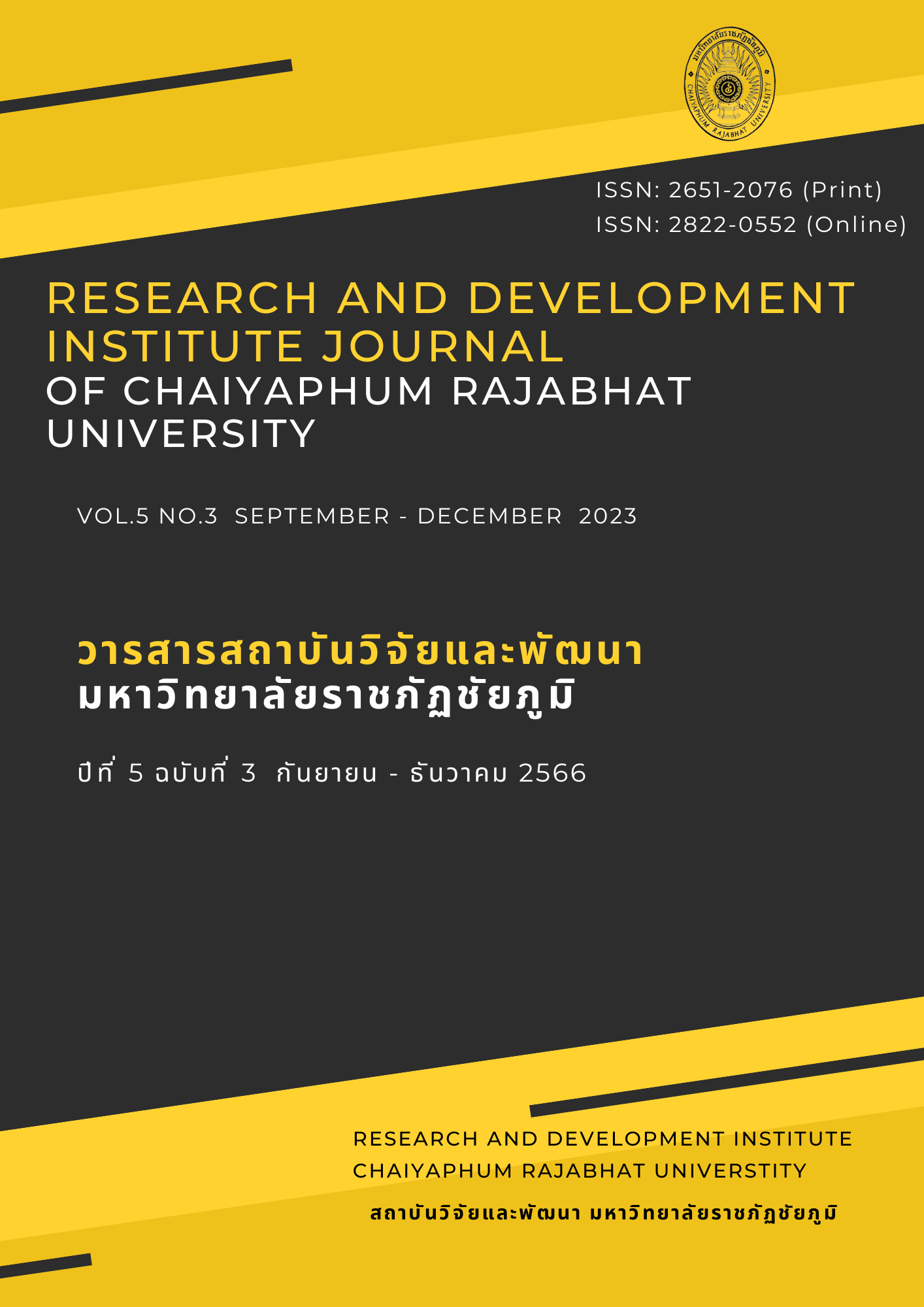Development of Buddhist Honest Livelihood of Villagers by Utilizing Recycling Waste under the Circular Economy-based Concept in Ban Pom Subdistrict, Phra Nakhon Si Ayutthaya District
Main Article Content
Abstract
This research had two objectives: 1) to develop the right livelihood based on Buddhist principles of villagers by utilizing recycling waste under the circular economy concept. 2) to evaluate the outcomes of right livelihood development based on Buddhist principles of villagers by utilizing recycling waste under the circular economy concept. The research was action research. A research area was located in Ban Pom, Village No. 3, Ban Pom Subdistrict, Phra Nakhon Si Ayutthaya District, Phra Nakhon Si Ayutthaya Province. There were fifteen villagers participating in the research. Data collection and action were conducted according to the concepts of Kurt Lewin. The data were analyzed by using content analysis. The results were as follows.
1) The results of vocational development based on Buddhist principles of villagers by utilizing recycling waste under the circular economy concept found that a team of lecturers provide training in plant containers and furniture making by using discarded car tires. The villagers had practiced making their own plant containers and furniture sets. Meanwhile, some villagers had taken the knowledge from the lecturers to the next level by making inventions from tires (dolls). Therefore, throughout the development period in the community, villagers could make
3 sets of furniture, nearly 20 plant containers, and 2 inventions from car tires (dolls). 2) Evaluation results of vocational development based on Buddhist principles of villagers by utilizing recycling waste under the circular economy concept found that the villagers passed the 3 aspects of livelihood development assessment as Livelihood, Interpersonal Relationships, and Suitable Environmental Conditions.
Article Details

This work is licensed under a Creative Commons Attribution-NonCommercial-NoDerivatives 4.0 International License.
Permission to use text, content, images, etc. of publication. Any user to read, download, copy, distribute, print, search, or link to the full texts of articles, crawl them for indexing, pass them as data to software, or use them for any other lawful purpose. But do not use it for commercial use or with the intent to benefit any business. Published under a Creative Commons Attribution-NonCommercial-NoDerivatives 4.0 International License.

This work is licensed under a Creative Commons Attribution-NonCommercial-NoDerivatives 4.0 International License
References
กรมการพัฒนาชุมชน กระทรวงมหาดไทย. (2561). แนวทางการสร้างสัมมาชีพชุมชน ปี 2562. กรุงเทพมหานคร: บริษัท บีทีเอสเพรส จำกัด.
กรมควบคุมมลพิษ กระทรวงทรัพยากรธรรมชาติและสิ่งแวดล้อม. (2559). แผนแม่บทการบริหารจัดการขยะ
มูลฝอยของประเทศ (พ.ศ.2559 -2564). กรุงเทพฯ: บริษัท แอคทีฟพริ้ท์ จำกัด.
กลุ่มงานวิจัยและพัฒนา สถาบันการพัฒนาชุมชน. (2562). ปัจจัยที่มีผลกระทบต่อความสำเร็จการขับเคลื่อนสัมมาชีพชุมชน. รายงานการศึกษา กรมการพัฒนาชุมชน กระทรวงมหาดไทย.
ชบาไพร ชัยหาเนตร์ และภักดี โพธิ์สิงห์. (2563). การสร้างสัมมาชีพชุมชนตามหลักปรัชญาของเศรษฐกิจพอเพียง. วารสารมหาจุฬาคชสาร, 11(1), 54-55.
พิชิต ฤทธิ์จรูญ. (2562). การประเมินโครงการ: แนวคิดและการประยุกต์ใช้. กรุงเทพมหานคร: บริษัท เฮ้าส์ ออฟ เคอร์มิสท์ จำกัด.
ภัทราพร เกษสังข์. (2559). การวิจัยเชิงปฏิบัติการ. กรุงเทพมหานคร: สำนักพิมพ์แห่งจุฬาลงกรณ์มหาวิทยาลัย.
เเม่ชีกฤษณา รักษาโฉม และคณะ. (2023). แพลตฟอร์มดิจิทัลเพื่อการขับเคลื่อนชุมชนปลอดขยะวิถีพุทธภายใต้แนวคิดเศรษฐกิจหมุนเวียน. วารสารสันติศึกษาปริทรรศน์ มจร, 11(2), 736-737.
วรรณดี สุทธินรากร. (2562). การวิจัยเชิงคุณภาพ: การวิจัยในกระบวนทัศน์ทางเลือก. กรุงเทพมหานคร: สยามปริทัศน์.
สถาบันวิจัยวิทยาศาสตร์และเทคโนโลยีแห่งประเทศไทย กระทรวงวิทยาศาสตร์และเทคโนโลยี. (2562). เศรษฐกิจหมุนเวียน…ที่ทุกคนควรรู้. ปทุมธานี: สถาบันวิจัยวิทยาศาสตร์และเทคโนโลยีแห่งประเทศไทย.
สำนักงานส่งเสริมการปกครองส่วนท้องถิ่น. (2565). โครงการอยุธยาบ้านสวย เมืองสะอาด. (แผ่นพับ). ม.ป.ท.
สุทัศน์ ประทุมแก้ว และคณะ. (2562). การพัฒนาผลิตภัณฑ์และส่งเสริมสัมมาชีพของหมู่บ้านรักษาศีล 5 ในจังหวัดศรีสะเกษ. รายงานการวิจัย วิทยาลัยสงฆ์ศรีสะเกษ มหาวิทยาลัยมหาจุฬาลงกรณราชวิทยาลัย.
BrandInside. (2565). ขยะพลาสติกไทย ติดอันดับ 12 ของโลก ปริมาณ 4.8 ล้านตันต่อปี หลักๆ จากความนิยม Food Delivery. https://brandinside.asia/plastic-pollution/
Y. Zhang and B. M. Wildemuth. (2009). Qualitative Analysis of Content. In B. M. Wildemuth, Ed., Applications of Social Research Methods to Questions in Information and Library Science. (pp. 1-12). Libraries Unlimited.

